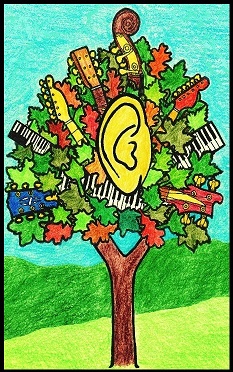 In chess, there are entire books about opening moves, and the strategic implications of each opening. It’s the same way with music. How you introduce music to someone with no prior knowledge is important. You never get a second chance to make a good first impression.
In chess, there are entire books about opening moves, and the strategic implications of each opening. It’s the same way with music. How you introduce music to someone with no prior knowledge is important. You never get a second chance to make a good first impression.
Even though many people have learned to play from traditional, reading-based method books, this is not the best way to start beginners. Beginners on piano, guitar and bass can learn to play faster “by concept” and by ear than by devoting large blocks of time to learning staff notation. It is more efficient for beginners to concentrate on mechanics, ear training, and getting generally acclimated to interacting with music. For beginners, reading slows down the speed of their playing, because they can play much faster than they can read.
Another problem is that people who form their basic concepts about music through reading, as opposed to guided interaction with live music, often become so permanently dependent on written music that they never learn to feel at home in situations that require real-time interaction, and a degree of improvisation. They can’t relate to any music they can’t see. In fact, it goes deeper than that. Many amateur classical musicians don’t practice any technical routines which don’t involve reading music.
They’re never free to just watch their hands while they play. Some classically-trained teachers still push the idea that you don’t really know a technique, or a piece of music, until you can play it without looking at your hands. This is another misguided classical bias.
For too many classically-trained musicians, reading music becomes a barrier to ever learning how to interact with real music in real time. Their total absorption with written symbols colors all of their ideas about music, including their ideas about the best ways to teach music.
Reading slows your technical progress when you’re first learning to play. You can easily learn to play things in your first few lessons that you won’t be able to read for months or even years. There are plenty of ten year-olds with two years of lessons who are playing guitar parts by ear that twenty year-olds with ten years of reading instruction would be hard-pressed to read, let alone sight-read.
What is the best way to introduce new students to the guitar, the piano, and the bass guitar? The idea is the same for all three instruments – guided practice with simple, repetitive music tracks. But each instrument presents a different set of challenges for first-time beginners.
Beginning music students have a psychological quirk. When a beginning student learns how to play just one strum, bass note, or piano chord in time with the chord changes in a song, then the student is satisfied that she or he is “playing” the song. Even though the student is vaguely aware that their part doesn’t sound exactly like the bass, guitar or piano in the song, they still chalk it up as a “win.”
The best way to start new guitar or piano students is to teach them how to play just two chords. Then, play a music track with only those two chords, and practice changing in time between them. This is something most people, including kids, can learn in a few minutes. Students who learn this way leave their first lesson feeling empowered. They leave feeling confident that they can learn to play music, because they’ve proven to themselves that they can play along with at least one real song, even if they’re not exactly replicating the part from the recording.
Every student I’ve ever taught knows instinctively what a chord change sounds like, once you show them what a chord change is. In a few minutes, they can zero-in on when the chords change in a song, even if they don’t know what the chords are.
The first few minutes with first-time beginners aren’t always pretty to watch. There’s usually some momentary confusion while they focus on learning to move their fingers in time with the music track. At this point, the teacher should sit back for a few minutes while the student figures things out.
Nothing a beginner does is perfect at first, so there’s no reason to point out every mistake. Playing along with a live groove for the first time is like learning how to step onto a moving escalator. After a little practice, it’s second nature.
Teachers might have to help new students to physically place their fingers on the keys or strings. On both keys and strings, the first technical challenge is learning to form an arch with your fingers. String players need to learn to arch the fingers of their left hand, as they touch their fingers to the strings. Piano players need to arch their fingers in both hands as they touch the keys. A pencil or (unused) chopstick under their fingers can help them learn to arch their fingers.
Adhesive markers on the keys can be helpful to students learning the keyboard. Many piano teachers keep a dot marker on middle C. I usually keep three colored dots on the keys. One on middle C, and one each on F and G below middle C. Color-coded chords usually aren’t necessary since you have the recurring pattern of black keys as visual markers. To me, it’s just as effective to simply teach shapes based on a specific key.
Teaching Beginners By Ear – Part 2
© 2019, 2020 Greg Varhaug